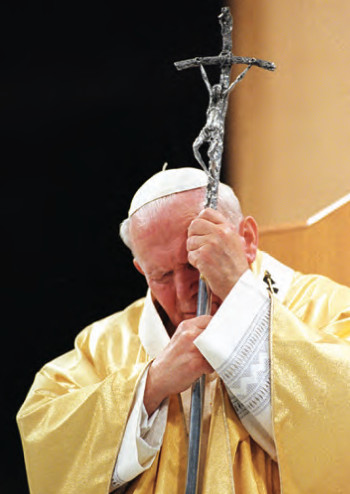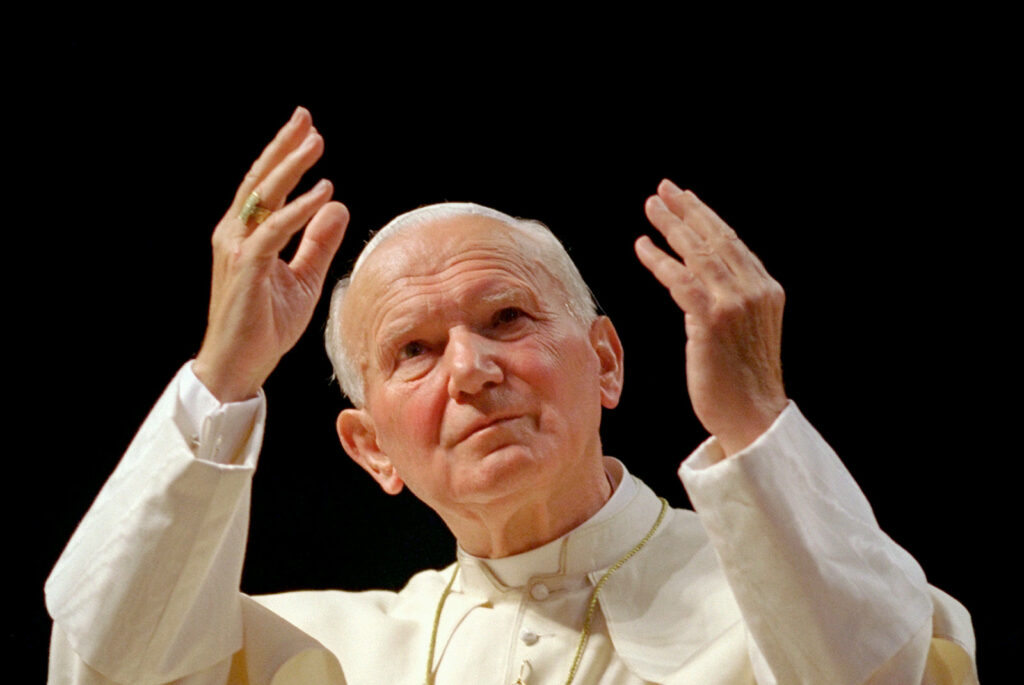1920-2005
Feast day: Oct. 22
A life defined by suffering in his early years drew to a close with another kind of suffering. Having lost his mother at age 8, his brother at 12 and his father at 21 — in addition to the atrocities and injustices perpetrated against his Polish countrymen during World War II — Karol Wojtyla drew the strength necessary for his survival from the Eucharist. Resolved to become a priest, despite the dangers and difficulties it presented to him, Karol knew in his heart the fruits that the Eucharist can bear in our lives. And, as an elderly man suffering from the effects of Parkinson’s disease, his celebration of the Eucharist — with a quivering voice, shaky hands and weakened body — gave a great witness to the whole world of Christ’s love made present in the Eucharist.
The images of the beleaguered pontiff in his final years have left a lasting memory for many today. The reverence for the Eucharist radiated from his tired eyes; the need for the Eucharist was understood by his perseverance through infirmity. John Paul II’s great love for the Eucharist prompted his declaration of a “Year of the Eucharist,” still underway when he died on April 2, 2005.
“Let Jesus present in the Blessed Sacrament speak to your hearts. It is he who is the true answer of life that you seek. He stays here with us: he is God with us.”
So much can be said of John Paul II’s pontificate. He was a key player in the collapse of communism in Europe, which forced him from university to hard labor in a limestone quarry and necessitated his studies in an underground seminary and ordination in secret in 1946. In the wake of widespread confusion among the faithful and ecclesiastical in-fighting after the Second Vatican Council, John Paul II — who became a bishop in 1958 and was an active participant in the council — brought clarity and unity. He contributed extensively and definitively with a robust magisterium, also overseeing the publication of the new Catechism of the Catholic Church and a revision of the Code of Canon Law. He was one of the most consequential figues on the world stage in the 20th century, and he left a mark on the life of the Church not soon to be forgotten.

CNS file photo by Nancy Wiechec
To a world that adopted what he called a “culture of death,” John Paul also provided a lasting legacy by his witness of strength through weakness. That is in many ways what made his very public final illness and suffering a display of life’s meaning and worth. He presented to the world what’s at the heart of Eucharistic discipleship: that in Christ alone does man find meaning.
John Paul’s teachings offered a unique motivation to promote Eucharistic renewal in the life of the Church so that Catholics could truly come to recognize the sacrament as the source and summit of its life and activity. He invited Catholics to restore “Eucharistic amazement” to their spiritual lives through various initiatives and pastoral texts that continue to educate, inspire and share the Church. He wanted “to banish the dark clouds of unacceptable doctrine and practice so that the Eucharist will continue to shine forth in all its radiant mystery.” And he led the way by example. “Let Jesus present in the Blessed Sacrament speak to your hearts,” he said in 1997. “It is he who is the true answer of life that you seek. He stays here with us: he is God with us. Seek him without tiring, welcome him without reserve, love him without interruption: today, tomorrow, forever!”
So captivating and respected was John Paul that his funeral brought together the largest gathering of heads of state outside of a United Nations gathering. And it likely was one of the largest assemblies in Christian history, with more than 4 million in Rome for the nine days of mourning. Pope John Paul II was canonized in 2014, a formal recognition by the Church of what the crowds sought when they chanted “santo subito” (immediate sainthood) after his death.
Michael R. Heinlein is editor of OSV’s Simply Catholic. He writes from Indiana. Taken from the “Inspired by the Eucharist” saint booklet.

